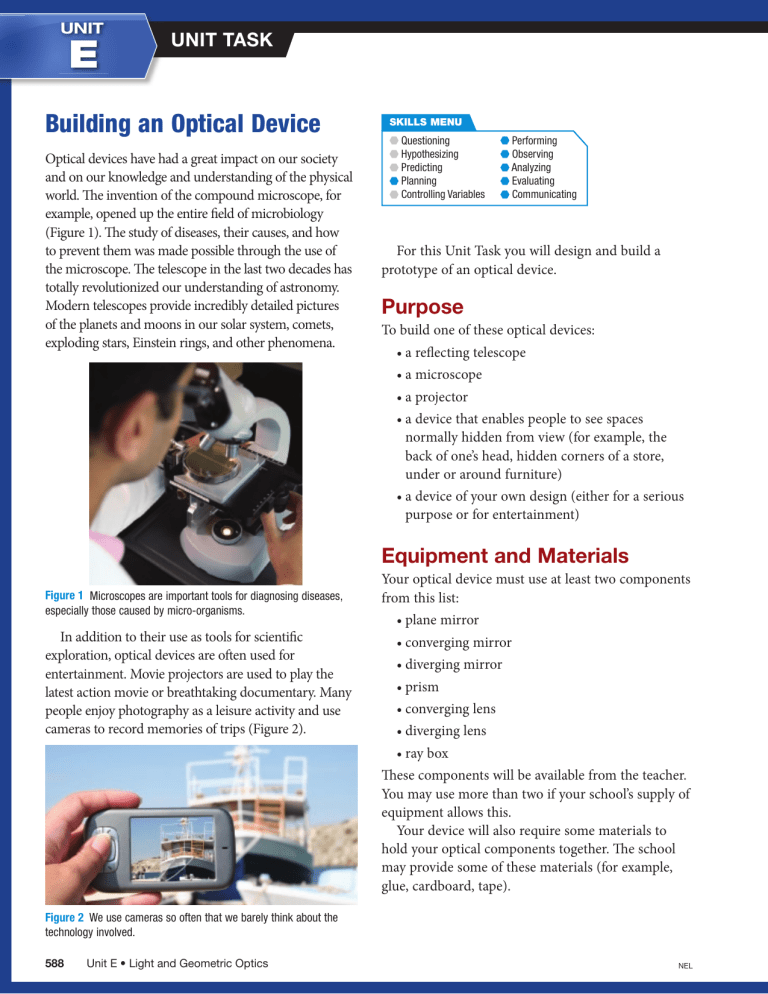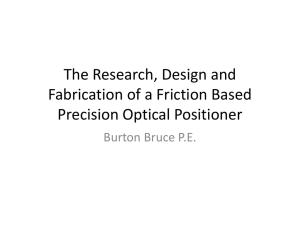
UNIT E UNIT TASK Building an Optical Device Optical devices have had a great impact on our society and on our knowledge and understanding of the physical world. The invention of the compound microscope, for example, opened up the entire field of microbiology (Figure 1). The study of diseases, their causes, and how to prevent them was made possible through the use of the microscope. The telescope in the last two decades has totally revolutionized our understanding of astronomy. Modern telescopes provide incredibly detailed pictures of the planets and moons in our solar system, comets, exploding stars, Einstein rings, and other phenomena. SKILLS MENU Questioning Hypothesizing Predicting Planning Controlling Variables Performing Observing Analyzing Evaluating Communicating For this Unit Task you will design and build a prototype of an optical device. Purpose To build one of these optical devices: • a reflecting telescope • a microscope • a projector • a device that enables people to see spaces normally hidden from view (for example, the back of one’s head, hidden corners of a store, under or around furniture) • a device of your own design (either for a serious purpose or for entertainment) Equipment and Materials Figure 1 Microscopes are important tools for diagnosing diseases, especially those caused by micro-organisms. In addition to their use as tools for scientific exploration, optical devices are often used for entertainment. Movie projectors are used to play the latest action movie or breathtaking documentary. Many people enjoy photography as a leisure activity and use cameras to record memories of trips (Figure 2). Your optical device must use at least two components from this list: • plane mirror • converging mirror • diverging mirror • prism • converging lens • diverging lens • ray box These components will be available from the teacher. You may use more than two if your school’s supply of equipment allows this. Your device will also require some materials to hold your optical components together. The school may provide some of these materials (for example, glue, cardboard, tape). Figure 2 We use cameras so often that we barely think about the technology involved. 588 Unit E • Light and Geometric Optics NEL Procedure SKILLS HANDBOOK 3.B., 7.A. Your school may require that school materials stay on school property. If this is the case, your teacher will allow you time to construct, test, and modify your device in the Science classroom or lab. 1. Select a device that you will construct. 2. Design your device. Your design should include a neat, scale drawing. 3. Prepare a list of materials that you will need. Have your teacher review this list. 4. Construct a prototype of your device. 5. Test your prototype to see how well it works. 6. Modify your prototype until it produces a result that you are satisfied with. This final version of the prototype will be your finished device. Analyze and Evaluate (a) How well does your device do what you want it to do? (b) What problems did you run into in construction? (c) How did you solve these construction problems? (d) Describe the image that your device produces under these headings: • magnification • quality of image • image characteristics ASSESSMENT CHECKLIST Your completed Performance Task will be assessed according to these criteria: Knowledge/Understanding ✔ Demonstrate a knowledge of geometric optics. ✔ Demonstrate a knowledge of the imaging properties of optical components. Thinking/Investigation ✔ Develop a plan for constructing the optical device. ✔ Incorporate safety principles. ✔ Incorporate environmental considerations. ✔ Perform the task in an organized manner. ✔ Analyze the results. ✔ Evaluate the design and modify it as necessary. Communication ✔ Prepare an appropriate lab report addressing the finalized design, the materials used, a scale diagram, and an evaluation of the device’s effectiveness. ✔ Communicate clearly during your design demonstration. ✔ Demonstrate an understanding of ray diagrams and the proper symbols of optical components. Application ✔ Use two or more optical components together. ✔ Achieve the stated goal with the optical device. ✔ Build a mechanically sound, environmentally friendly, and safe device. ✔ Pay attention to the overall appearance and aesthetics of the device. (e) How easy is your device to use? (f) How would you do this activity differently if you were to do it all over again? Apply and Extend SKILLS HANDBOOK 4.A., 4.B. (g) Draw a neat ray diagram to illustrate how your device produces an image. (h) Demonstrate your device to your class. (i) Research real-life examples of the device that you designed. GO TO NELSON SCIENCE NEL Unit E Task 589




